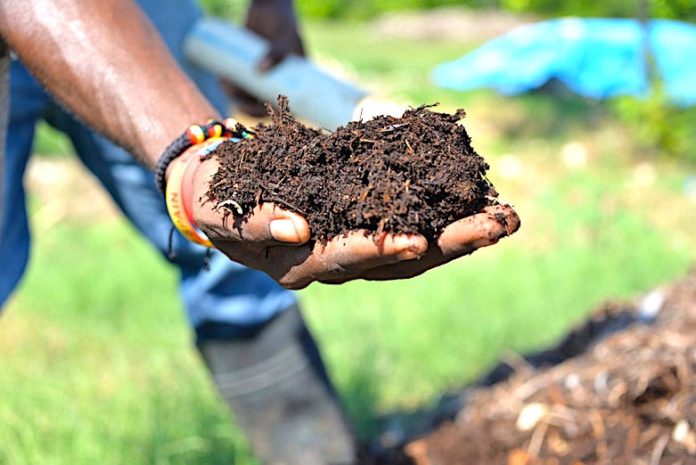
 By Dr. Chris Hergesheimer
By Dr. Chris Hergesheimer
Delmas 33 in Port Au Prince is a densely populated neighborhood area that buzzes with life. Vendors hawk cold drinks and hot Fritay, motorcycles and tap-taps thread confident lines through the crowded streets. Shops clamber with daily activity. But on a quiet and unassuming side street, just around the corner from Hopital Universitaire de le Paix, is the headquarters of an operation that is literally taking ‘a movement’ to a whole new level.
Agricultural productivity and poor quality sanitation systems (where they do exist) are two major challenges facing Haiti. Both of these challenges directly impact the health and quality of life of Haitians. Agriculture plays a dominant role in the economy, holding particular importance for nearly 60 percent of the population who depend on it for their survival[1]but most farmers operate at a subsistence level and many farmers do not produce sufficient food to satisfy household consumption[2].
Overall, domestic production falls well short of national consumption and food imports are in the range of 50-60%[3]. A depleted natural environment, alongside the lack of irrigation and fertilizer—have direct consequences on both the timing of yearly plantings as well as the overall yield per hectare. Individual productivity challenges have been coupled with minimal government investment in the sector[4].
In addition to challenges in the agricultural sector, Haiti has extremely poor health indices. The life expectancy at birth is 62.7 years and the estimated IMR is 64 per 1,000 live births.[5].Haiti has one of the worst diarrheal incidence rates in the world for children due to the lack of centralized sewer systems, waste treatment, and limited availability of potable water.[6] And some of the causes for these outcomes are not new. As far back as 1900, public health specialists reported on the close links between poor water quality and disease in Haiti[7]. However, nearly 120 years later, lack of access to appropriate sanitation, both toilet facilities that ensure waste treatment and clean drinking water, continue to contribute to these poor health outcomes.
Only 28 percent of the population in Haiti has access to a toilet.
The cholera epidemic that began in 2010 exemplified these challenges. Infectious water-borne diseases such as cholera and typhoid thrive in densely populated areas, particularly within Haitian capital Port-au-Prince. There are painted murals on public cement walls to educate and inform. Only 28 percent of the population has access to a toilet and utilization rates, even for those with toilets, are actually lower than would be expected. This is a country where waterborne diseases caused by poor hygiene and sanitation practices are responsible for 20 percent of deaths of under-five children[8]. Nearly 60% of rural Haitian schools don’t have a single toilet[9]. Haiti is the most underserved country in the western hemisphere in terms of water and sanitation infrastructure. People die from it daily.
Improving Haiti’s sanitation infrastructure is critical. However, in a world with administrative, infrastructural, and governance challenges, these issues cannot be dealt with by simple solutions. Or can they be? And can a sanitation solution focused on improving health, safety, and dignity actually contribute to addressing other challenges- for instance, the agricultural productivity problem?
Sustainable Organic Integrated Livelihoods (SOIL)
On the morning of January 24th, 2018 I walked into the office of Sustainable Organic Integrated Livelihoods (SOIL)[10]. Sustainable Organic Integrated Livelihoods (SOIL) is an organization that has been working on ecological sanitation in Haiti since 2006. In 2009, SOIL developed the nation’s first waste treatment site to treat human faeces using thermophilic composting processes that exceed the standards set by the World Health Organization for the safe treatment of human waste.
Since the earthquake in 2010, SOIL has developed an in-home composting toilet that eliminates pathogens and creates re-usable nutrient-rich compost [11][12].SOIL is now active in both Port-au-Prince and Cap Haitien with over 1,100 toilets serving more than 6,000 individuals. SOIL’s business model favors local job creation and champions participatory community education to spread its message and highlight their positive impacts.
There has been decades of work pertaining to the food-health nexus—the point at which analyses of health outcomes and food studies intersect and/or an examination of the relationships between these systems. The health impacts of food systems are complex, multi-scalar, and not always obvious [13]. Health outcomes are connected to large and broad processes of how we produce, distribute, market, consume and dispose of food. This latter area of concern—how we dispose of food—is an understudied area. SOIL’s activities open up a new research focus within the growing food health nexus.
The backyard of the SOIL office was once full of garbage, stagnant water, and mosquitos. Now it is literally an oasis.
The backyard of the SOIL office was once full of garbage, stagnant water and mosquitos. Now it is literally an oasis transformed by compost and through permaculture techniques. Framed by electric green foliage; banana trees, palm trees and grasses, muddy water runoff from the urban city streets is cleaned through biofiltration and burbles bucolically through a tiny stream. This is a real example of rejuvenation and restoration at work. You never know what lies behind the walls of complexes in the heart of this pulsing city.
At first glance, SOIL represents a direct intervention in the ‘waste’ stage of the food cycle. While we normally think of waste within the food cycle as “food waste” (often in the form of food scrap compost or garbage), this is not quite the case with SOIL. Or maybe we’ve just been conceiving of food waste too narrowly?
There is no doubt that human excrement is an extremely renewable and plentiful resource. And an ecological paradigm in sanitation is based on ecosystem approaches and the closure of material flow cycles [14]. So, human waste is contained, coordinated, composted, and commercialized back into the production stage of the food cycle as organic fertilizer. By redirecting and transforming the nutrients normally lost to human waste, SOIL “closes the loop”[15] and draws from daily activities that are both natural and necessary to provide a cheap and plentiful primary production input.
But the reality is, between the daily outputs and seasonal inputs, SOIL is tackling a range of other challenges. Even with my limited experience and knowledge about these issues, it is clear to me that SOIL deserves to be seen as a solution of prime importance. SOIL is improving a number of major issues (both proximal and distal, both short term and long term) that coalesce at the intersection of health, dignity, ecology, economics, and food production.
Firstly, dry composting toilets overcome the existing lack of access to water and sewers needed to support water-based sanitation. Only 2-8% of households in Haiti have any piped water [16]. The process of getting water is a daily investment of time and resources. Between washing, cooking, drinking and sanitation, households require a significant amount of water. While conventional high flush toilets can use up to 75 liters of water a day, even the most basic types of toilets, pit latrines and pour/flush (PF) toilets that are common in Haiti, require daily water to operate.
On average, pit latrines utilize between 1-2 liters per person/day and PF toilets use 6-8 liters per person/per day [17]. And while flush toilets may signal the trappings of modernity to some around the world, utilizing precious water is counter-intuitive, even more so when considering where the ‘flushed and forgotten’ waste actually goes. Dry toilets on the other hand cut the amount of water needed way down. And the evidence speaks for itself.
“There are many families in the neighborhoods where we work in Port-au-Prince who have switched from using a flush toilet to a household composting EkoLakay toilet […] The 200-350 GDES (approximately 3.00 to 5.50 USD) per month that customers pay for the service is less than the cost of the water inputs necessary to operate flush toilets.” (Miller, N.. Personal communication, winter 2018).
The converted are saving substantially on water costs each month and that’s a motivating factor. Plus, the government mobilizing and building a centralized sewer system and waste treatment plant is a project of herculean proportions. The construction of such a system also encounters feasibility barriers in neighborhoods with contested land tenure, in dense urban neighborhoods that have expanded rapidly and simply don’t have space, or in communities with high water tables.
Regardless of the combination of barriers, leapfrog technologies like EkoLakay offer a sustainable and scalable way forward. Furthermore, in the midst of a coming global water crisis and increasingly intense natural disasters, SOIL’s toilets are intentionally resilient to both droughts and flooding. The incorporation of resource recovery into the system actually makes them a better sanitation solution for countries around the world, even in developed nations that have functional municipal-level waste treatment systems.
Secondly, SOIL improves agricultural productivity via affordable, natural fertilizer. In 2017, 84 metric tons of Konpòs Lakay compost was sold for agricultural and reforestation efforts across Haiti. This fertilizer directly increases agricultural productivity. In some cases and for some crops by as much as 200-400 percent based on recent field studies (Miller, N.. Personal communication, winter 2018). A 40 lb bag sells for $6 USD. But will people shell out the money to buy it?
“SOIL treats and transforms up to 50 metric tons of waste each month. We’ve been operating on a waitlist for compost sales for two years and struggled to keep up with local demand. As we’re been scaling up our sanitation service, we’re just now starting to develop a stock that goes onto be used by purchased by local businesses, organizations working on agricultural and reforestation projects, and families purchasing the compost for their personal gardens” (Miller, N.. Personal communication, winter 2018).
I believe people’s willingness to pay for this compost is directly connected to the results.
“For people that don’t have money for any soil amendments, $6 USD is still going to be prohibitively expensive, but for farmers that have been buying chemical fertilizer, well, we have collaborated on research that compares our organic compost to its chemical counterparts and are proud to report that our compost produces a bigger yield.” (Miller, N.. Personal communication, winter 2018).
So, just to recap at this point; at the end of the day, it is cheaper to operate this toilet than a water toilet (if you even have water). Someone services it for you for a small fee, and then you pay for some agricultural inputs. However, if you are a farmer, you get way more in agricultural output, and that makes sense from a livelihoods perspective.
Third, SOIL reduces the general public health burdens that stem from lack of access to safe sanitation options and improves the health and safety of certain individuals by providing a composting toilet for their home. 75% of Haiti’s population lack access to a toilet and this is where SOIL’s work began – dignified, safe, ecofriendly-composting toilets.
In densely populated urban areas, lack of sanitation access can have greater negative health impacts as people are in close proximity and the risk of spreading pathogens is increased. There are also more general concerns about dignity and safety that are connected to the daily search for a place to go to the bathroom. Physical and sexual assaults are a common risk facing women and girls in the developing world who have to search for a toilet.
One study suggests that women and girls living in developing countries spend 97 billion hours collectively finding a place to go in the open [18]. Convenient sanitation access increases productive capacity. SOIL’s model addresses both these challenges, all the while employing 84 people in the growing sanitation sector. The toilet is in your house (safe and convenient) and users are provided with a weekly collection service, repairs, and maintenance as needed for a small monthly fee. “It really is the gold standard to have a private toilet in your home” (Miller, N.. Personal communication, winter 2018).
Finally, SOIL is a leader in participatory, community education and training programs to help tackle taboos and improve knowledge about healthy sanitation practices. They are also mobilizing the power of community capacity in general. In the last decade, SOIL has conducted ecological sanitation seminars for more than 1,000 participants in Haiti. They engage in consultancies throughout the world in order to support the scale-up of these technologies.
I have to admit, the SOIL toilets are fascinating. They don’t smell and they look way cleaner and more comfortable than many of the toilets I’ve used during my time in Haiti. I can’t help but think about the first conversation, about how you break it down for people. I point out that there seems to be a ‘double taboo’. The first taboo being talking openly about going to the bathroom (in general) and the second being taking your (and strangers’) waste, trusting the process, and then growing food in it. However, turns out I’m far from the expert on taboos. SOIL claims that people are in fact quite willing to talk about and engage with both these issues.
“There is some resistance in different communities, like there is in any part of the world, but […] I think as long as we can get people in the door to learn about the process or know someone who has this toilet in their neighborhood, it really doesn’t take a lot of convincing” (Miller, N.. Personal communication, winter 2018).
And regarding the health concern of pathogens, SOIL collaborates with academic institutions across the world to showcase the process and the safety inherent in their model. The waste is mixed with chipped biomass like peanut shells, and sugar cane bagasse. Strict safety protocols for workers are employed. The soil is meticulously tested twice through the process for indicator pathogens like E. coli and Ascaris worms and is fully transformed into lush agricultural-grade lush compost after six to nine months. It’s solid science and people can get behind this.
Conclusion
When I make it back into the swirling cacophony of the street, I can’t help but think that this initiative is truly saving lives. I also can’t help but think that in a metropolitan area of approximately 2.6 million people (as of 2015) that creaks under the pressure of its own lack of infrastructure, 1,100 toilets is literally drops in the bucket.
However, leapfrog technologies like EkoLakay grow quickly and widely, and according to co-founder Dr. Sasha Kramer, hold the potential to make Haiti a leader in sustainable technologies in the years to come. They just need a bit more investment. A blended revenue approach—with innovative public financing, individual contributions, and private sector revenues co-financing the solution—is the future to make more broad adoption possible. Despite what some people think and some challenges ahead, SOIL makes the future look bright for Haiti.
But at the personal level, how is success measured? Well, the easiest way to find out if you are succeeding is to ask people.
“In a recent customer satisfaction report in Port-au-Prince, families reported that the primary benefits to EkoLakay were the money they are saving, the sense of safety and security for their families and their improved health. Those are the biggest three benefits that people are reporting back to us at a personal level. We also know that people care about the environment in Haiti – they have a desire to support agricultural and ecological restoration. But I do think on a day to day basis, the biggest impact people are feeling in the communities we serve is the improved safety, health and affordability of our in-home Eco-Lakay toilets” (Miller, N.. Personal communication, winter 2018).
Financial savings, increased health, dignity and safety for users, eco-friendly repurposing of waste, increased agricultural productivity, local job creation and empowered community education—this sounds like a successful solution to me.
Acknowledgments: I am grateful to Natalie Miller, Communications and Development Associate at Sustainable Organic Integrated Livelihoods (SOIL) for sharing her knowledge and expertise with me and supporting this submission. I would also like to acknowledge the rest of the SOIL team for their important and valuable work. Haiti Ap Vanse!
(Dr. Chris Hergesheimer holds a BA in Anthropology and MA in Sociology from Simon Fraser University. Chris has expertise in ethnographic research methods, food sovereignty, and international development. His recently completed Ph.D. work revolves around the relationship between Food Sovereignty and Fair Trade in high-value fruit chains. This work took him to rural Haiti and Ecuador.)
Endnotes
[1]Eitzinger, A, Läderach, P, Carmona, S, and Collet, L.. Haiti: Coffee and Mango Production in a Changing Climate. CIAT Policy Brief. (2014)
[2]Adelman, C. Haiti: testing the limits of government aid and philanthropy. Brown Journal of World Affairs. Spring/Summer. volume xvii, issue ii (2010).
[3]Dupuy, A. Disaster Capitalism to the Rescue: The International Community and Haiti After the Earthquake. NACLA Report on the Americas, 4314–19 (2010).
[4]Cohen, M. J. Diri Nasyonal ou Diri Miami? Food, agriculture and US-Haiti relations. Food Security, 5597–606. (2013) http://doi.org/10.1007/s12571-013-0283-7
[5]UNICEF Statistics: Haiti (2012). https://www.unicef.org/infobycountry/haiti_statistics.html
[6]Dowell, S, Tappero, J.W & Frieden, T. R. Public Health in Haiti—Challenges and Progress. The New England Journal of Medicine. Vol 364. 300-301. (2011)
[7]Gelting, R, Bliss, K, Patrick, M,Lockhart, G & Handzel, T.. Water, Sanitation and Hygiene in Haiti: Past, Present, and Future. American Journal of Tropical Medicine. Vol 89 665-670 (2013).
[8]Haiti Libre (2016). Haiti- Health: Only 28% of population has access to a toilet. Retrieved from http://www.haitilibre.com/en/news-17559-haiti-health-only-28-of-the-population-has-access-to-adequate-toilet.html
[9]Human Rights Watch (2014). Haiti: Students Need Safe Water, Toilets. Retrieved from https://www.hrw.org/news/2014/10/08/haiti-students-need-safe-water-toilets
[10]Sustainable Organic Innovative Livelihoods (SOIL) [Online]. www.oursoil.org
[11]Remington, C, Cherrak, M, Preneta, N, Kramer, S & Mesa, B. (2016). A Social Business Model for the provision of household ecological sanitation services in urban Haiti. A briefing paper for the Hare 39 WEDC International Conference, Kumasi, Ghana.
[12]Berendes D, Levy K, Knee J, Handzel T, Hill V.R. Ascaris and Escherichia coli Inactivation in an Ecological Sanitation System in PortauPrince, Haiti. PLoS ONE 10 (2015) e0125336. https://doi.org/10.1371/journal.pone.0125336
[13]Weiler, A.M, Hergesheimer, C, Brisbois, B, Wittman, H, Yassi, A & Spiegel, J.M. Food sovereignty, food security and health equity: a meta-narrative mapping exercise. Health Policy Planning30 (2015)
[14]Langerbraber, G & Muellegger, E. (2005). Ecological Sanitation—a way to solve global sanitation problems? Environment International. Vol 31 433-444 (2005).
[15]Kulkarni, C.. The Implications of Composting Toilets for Nitrogen Flows in Haiti. Report. Center for Environmental Studies, Brown University. 1-11 (2009)
[16]Varma, M. K, Satterthwaite, M. L, Klasing, A. M, Shoranick, T, Jean, J, Barry, D, Smith-Fawzi, M. C, McKeever, J & Lyon, E. Wòch Nan Soley: The Denial of the right to water in Haiti. Health and Human Nutrition in Practice. Vol 10 67-89 (2010).
[17]Gleick, P.. Basic Water Requirements for Human Activities: Meeting Basic Needs. Water International, Vol 21 83-92. (1996).
[18]Water Aid USA (2012). 1 in 3 women lack safe toilets. Retrieved from https://www.wateraid.org/us/media/1-in-3-women-lack-safe-toilets










